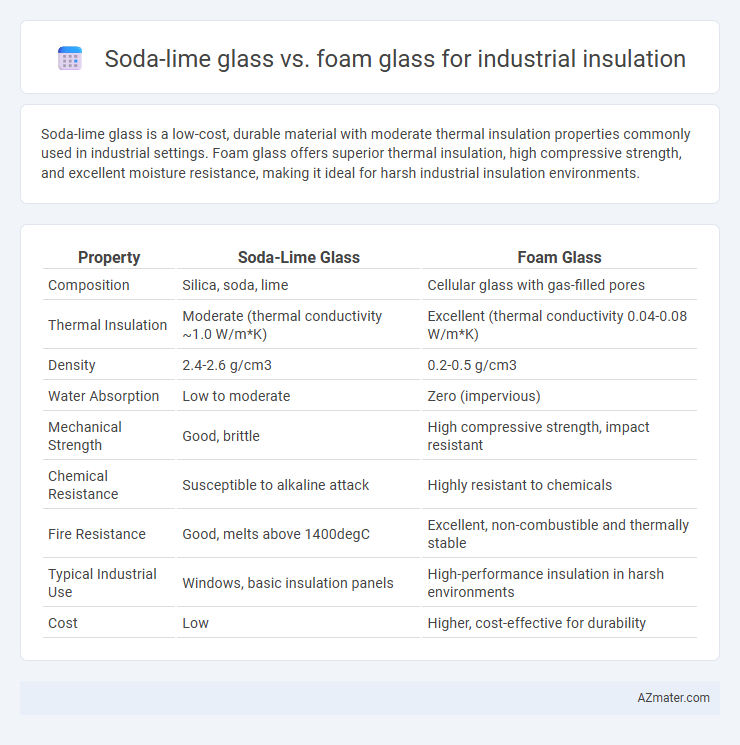Soda-lime glass is a low-cost, durable material with moderate thermal insulation properties commonly used in industrial settings. Foam glass offers superior thermal insulation, high compressive strength, and excellent moisture resistance, making it ideal for harsh industrial insulation environments.
Table of Comparison
| Property | Soda-Lime Glass | Foam Glass |
|---|---|---|
| Composition | Silica, soda, lime | Cellular glass with gas-filled pores |
| Thermal Insulation | Moderate (thermal conductivity ~1.0 W/m*K) | Excellent (thermal conductivity 0.04-0.08 W/m*K) |
| Density | 2.4-2.6 g/cm3 | 0.2-0.5 g/cm3 |
| Water Absorption | Low to moderate | Zero (impervious) |
| Mechanical Strength | Good, brittle | High compressive strength, impact resistant |
| Chemical Resistance | Susceptible to alkaline attack | Highly resistant to chemicals |
| Fire Resistance | Good, melts above 1400degC | Excellent, non-combustible and thermally stable |
| Typical Industrial Use | Windows, basic insulation panels | High-performance insulation in harsh environments |
| Cost | Low | Higher, cost-effective for durability |
Introduction to Industrial Insulation Materials
Soda-lime glass, a common industrial insulation material, offers cost-effective thermal resistance and chemical durability, making it suitable for applications requiring moderate temperature control and corrosion resistance. Foam glass insulation, composed of recycled glass, provides superior thermal insulation, moisture resistance, and high compressive strength, ideal for harsh industrial environments with extreme temperatures and heavy mechanical loads. Selection between soda-lime glass and foam glass depends on specific industrial requirements such as thermal conductivity, density, and environmental exposure conditions.
Overview of Soda-lime Glass
Soda-lime glass, composed primarily of sodium oxide, lime (calcium oxide), and silica, is a widely used material in industrial insulation due to its cost-effectiveness and ease of production. Its relatively low thermal conductivity and good chemical durability make it suitable for various insulation applications, although it lacks the exceptional thermal resistance of foam glass. Soda-lime glass is often chosen where budget constraints and moderate insulation performance are primary considerations, contrasting with foam glass's superior insulation efficiency and moisture resistance.
Overview of Foam Glass
Foam glass is an industrial insulation material composed of crushed glass and a foaming agent, resulting in a lightweight, rigid, and highly durable product with excellent thermal insulation properties. Unlike soda-lime glass, foam glass exhibits exceptional resistance to moisture, chemical corrosion, and fire, making it ideal for applications in harsh industrial environments such as cryogenics, petrochemical plants, and building insulation. Its closed-cell structure provides superior compressive strength and long-term performance, outperforming traditional soda-lime glass in thermal efficiency and environmental sustainability.
Thermal Insulation Properties Comparison
Soda-lime glass exhibits moderate thermal insulation properties with a typical thermal conductivity ranging from 0.7 to 1.0 W/m*K, making it less efficient for high-performance industrial insulation applications. Foam glass, composed of cellular glass with closed-cell structure, offers superior thermal insulation due to its low thermal conductivity of approximately 0.04 W/m*K and excellent thermal stability at high temperatures. The closed-cell microstructure of foam glass also provides enhanced resistance to moisture and chemical exposure, ensuring long-term insulation performance in industrial settings.
Mechanical Strength and Durability
Soda-lime glass exhibits moderate mechanical strength but lower durability under industrial insulation conditions due to its susceptibility to thermal shock and chemical corrosion. Foam glass provides superior mechanical strength, enhanced compressive resistance, and excellent durability thanks to its closed-cell structure that resists moisture, chemical exposure, and thermal cycling. Industrial insulation applications favor foam glass for its long-term stability and robust performance in harsh environments compared to soda-lime glass.
Chemical Resistance and Corrosion Protection
Soda-lime glass offers moderate chemical resistance but is prone to alkali and acid attack, making it less suitable for harsh industrial insulation environments requiring strong corrosion protection. Foam glass, composed of crystalline silicates, provides superior chemical resistance and excellent corrosion protection due to its closed-cell structure and inertness against most acids, alkalis, and solvents. This makes foam glass the preferred choice for industrial insulation applications involving exposure to aggressive chemicals and corrosive conditions.
Fire and Heat Resistance Capabilities
Soda-lime glass offers moderate fire and heat resistance with a typical softening point around 700degC, making it suitable for applications requiring basic thermal insulation. Foam glass excels in fire and heat resistance due to its closed-cell structure and high melting point above 1000degC, ensuring superior insulation and non-combustibility in extreme conditions. Industrial insulation often favors foam glass for its enhanced thermal stability, durability, and resistance to high-temperature exposure compared to soda-lime glass.
Environmental Impact and Sustainability
Soda-lime glass insulation often involves high energy consumption and emits significant CO2 during production, whereas foam glass insulation is made from recycled glass, reducing raw material waste and lowering the carbon footprint. Foam glass offers superior durability and chemical resistance, enhancing its lifecycle environmental benefits by minimizing replacement and maintenance needs. Both materials support industrial insulation, but foam glass ranks higher in sustainability due to its closed-cell structure that improves thermal performance while promoting circularity in industrial applications.
Cost Efficiency and Installation Factors
Soda-lime glass offers lower initial costs and easier availability, making it a cost-efficient choice for large-scale industrial insulation projects. Foam glass, despite a higher upfront price, provides superior thermal performance and moisture resistance, potentially reducing long-term maintenance expenses. Installation of soda-lime glass is simpler and quicker due to its lightweight and adaptability, whereas foam glass requires careful handling owing to its brittleness but benefits from durability in harsh industrial environments.
Best Applications for Soda-lime Glass vs Foam Glass
Soda-lime glass excels in applications requiring high transparency and chemical durability, making it ideal for architectural glazing, containers, and heat-resistant panels in industrial settings. Foam glass offers superior thermal insulation and moisture resistance, perfect for pipe insulation, cryogenic systems, and structural insulation in harsh environments. Selecting between soda-lime and foam glass depends on specific industrial needs, such as transparency versus insulating properties.

Infographic: Soda-lime glass vs Foam glass for Industrial insulation
 azmater.com
azmater.com